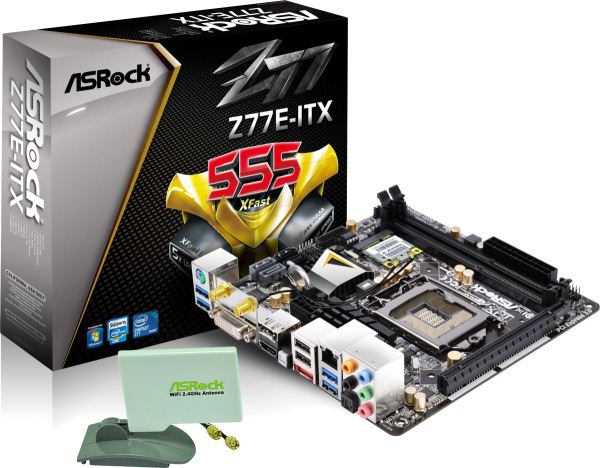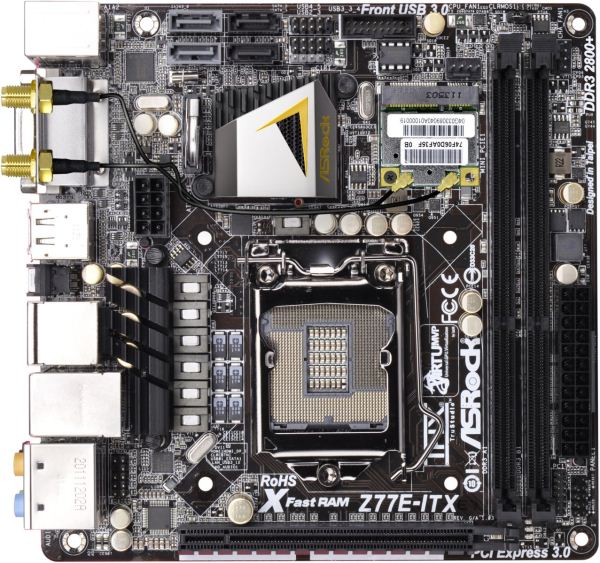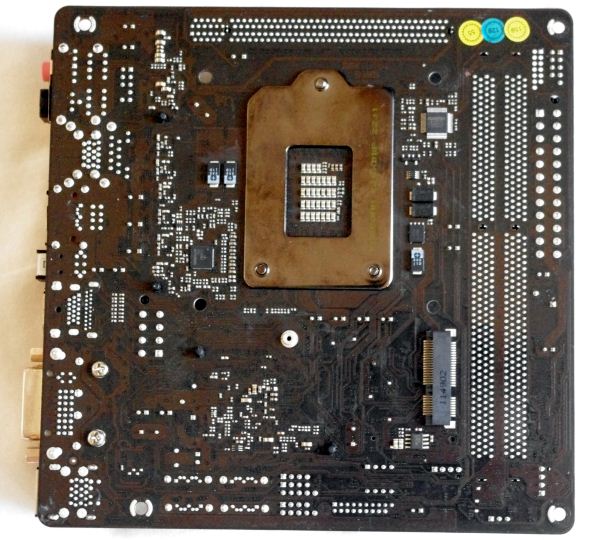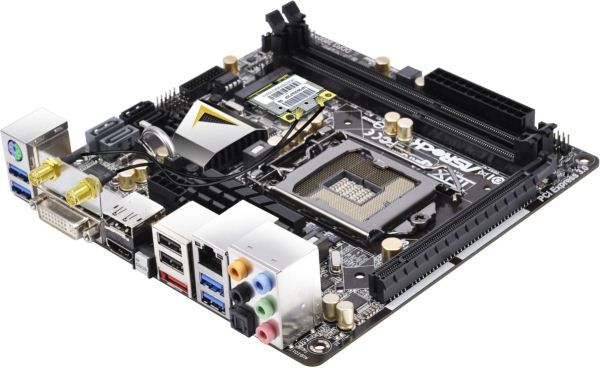Z77 mITX Round-Up: Five of the Best – MSI, Zotac, ASRock, EVGA and ASUS
by Ian Cutress on December 31, 2012 7:00 AM EST- Posted in
- Motherboards
- MSI
- ASRock
- EVGA
- ZOTAC
- Asus
- Ivy Bridge
- Z77
- mITX
ASRock Z77E-ITX Overview
Before I even started testing the ASRock Z77E-ITX, I could see murmurings online in the various forums I use about it. For the interests of remaining unbiased, I steered away from those threads. The ideal scientific test of a motherboard would be a double-blind study – the board can be reviewed and tested, but any tell-tale signs or markings on the product pointing it towards a single manufacturer would be removed. Unfortunately testing is not always scientifically perfect, but we can at least be as thorough as possible in our analysis.
The ASRock Z77E-ITX presents the user with a novel way (in the consumer desktop space) of solving the issue of limited PCB area – moving components to the rear of the motherboard. We are not talking just resistors – ASRock have moved the mSATA port to the rear. This frees up the main topside of the PCB for a mini-PCIe with 802.11b/g/n WiFi, a proper location for the 8-pin CPU connector, an easier-to-remove BIOS chip, and a lot more components on the board. This thing looks filled.
Other functionality on board gives us a Broadcom BCM57781 network controller, the Realtek ALC898 audio codec and an ASMedia ASM1042 USB 3.0 controller. The two 4-pin fan headers are found on the top left of the board, although on closer inspection the power delivery chokes may give cause for concern. Their open top design suggests iron core chokes, similar to those used on low end motherboards, rather than the iron powder or alloyed chokes on their higher end models. However after talking to ASRock, these are actually iron ferrite chokes, used for small space / high power systems such as servers. This should lead to reasonable temperatures under severe stress, and typically server parts are rated to be more than adequate for that severe stress.
The BIOS of the Z77E-ITX uses the older UEFI design of white on blue, compared to the new starry background design and distribution of options. We still get access to the System Browser, which cunningly gives a peak of the back of the board due to that mSATA placement, the Online Management Guard and Internet Flash for BIOS updates through the internet. We also get the dehumidifier functionality for equilibrating high-moisture situations inside and outside the case to reduce condensation in those climates. Software is standard ASRock, with ASRock always wanting to promote their XFast 555 system of RAM, LAN and USB. The latter may not be of use under Windows 8, and the chances of RAM cache use in a mITX are slim, but access over the network priority is a useful tool to have. While the fan controls are not the best, they did work in my testing over the range of tools available.
The ASRock Z77E-ITX sits at the low end in terms of cost in our review at $150 – significantly cheaper than the EVGA at least. With a weird orthogonal antenna in the box, DVI-I to D-Sub adaptor too, and performance which is not too far off from what we expect from the platform, the ASRock does pull at the wallet waiting for a build.
Visual Inspection
Like most motherboard manufacturers at the minute, ASRock has their color scheme – in this case we the aim is for a gold and black combination, however the way ASRock designs its motherboards means that we also get a lot of white. This is due to the placement of the components via SMT – in order to guide the automated process which places the components on board, each component has a small white box around where it should be. All these boxes printed on the board means that technically ASRock has less space to place components, and it alters the aesthetic perception of the product in the end.
Starting with the socket placement, ASRock like others in this review have placed the socket underneath the chipset and up against the memory/PCIe slots. This restricts coolers to the x-y dimensions specified by Intel, unless one invests in low profile memory. As always with mITX gaming builds, I would recommend an all-in-one liquid cooler. The socket area has access to both of the CPU fan headers on board – the 4-pin CPU header is above the mini-PCIe slot, and the 4-pin chassis header is to the top right of the memory slots. Arguably placing the two fan headers close together may not be the best idea in terms of placement.
The rear of the board is where we find this mSATA port. Now that mSATA drives are below the $1/GB, they become a wonderfully viable option in the motherboard space for those wanting to save space or who are not going RAID-0. (Even though there could be scope for two mSATA on motherboards in the future.)
North of the socket we have the chipset heatsink, which ASRock have decided not to connect to the power delivery heatsink. As mentioned previously, the style of the chokes used in the power delivery seems to suggest that simple iron cores are being used. Simple iron cores are the current low end and cheaper implementation of chokes, leading to lower efficiency and high heat loss, especially when compared to iron powder chokes, alloy chokes, super ferrite chokes, or PowIRstages. Talking with ASRock points these chokes towards the iron ferrite versions used in servers, meaning that they should still be able to provide enough power during overclocks, even if the mITX motherboard is not the ideal place to start overclocking a motherboard to the fullest – especially given that Ivy Bridge processors can get very hot in correlation to their voltage.
Around the chipset heatsink we get the SATA ports – two SATA 6 Gbps and two SATA 3 Gbps. The motherboard battery is stood straight out of the motherboard in order to save space, and below this we have the 8-pin ATX power connector. This is still in the middle of the board but perhaps not as bad as other implementations which require the power cables to stretch over everything in order to get to it. To the right of the chipset we have a USB 3.0 header, as well as the mini-PCIe port with a 2.4 GHz 802.11b/g/n WiFi module already strapped to it.

The rear IO panel looks more like a standard ATX build rather than a mITX oriented one. From left to right we have a combination PS/2, two USB 3.0 from an ASMedia ASM1042, the two antenna ports, a DVI-I, HDMI, DisplayPort, a Clear_CMOS button, two USB 2.0, an eSATA, a Broadcom BCM57781 network port, two USB 3.0 from the chipset and audio jacks containing an optical SPDIF output.
Board Features
| ASRock Z77E-ITX | |
| Price | Link |
| Size | Mini ITX |
| CPU Interface | LGA-1155 |
| Chipset | Intel Z77 |
| Memory Slots |
Two DDR3 DIMM slots supporting up to 16 GB Up to Dual Channel, 1066-2800 MHz |
| Video Outputs |
HDMI DisplayPort DVI-I |
| Onboard LAN |
Broadcom BCM57781 802.11 b/g/n WiFi |
| Onboard Audio | Realtek ALC898 |
| Expansion Slots |
1 x PCIe 3.0 x16 1 x mSATA 1 x mPCIe |
| Onboard SATA/RAID |
2 x SATA 6 Gbps (Chipset) RAID 0, 1, 5, 10 2 x SATA 3 Gbps (Chipset) RAID 0, 1, 5, 10 1 x mSATA 3 Gbps (Chipset) 1 x eSATA 3 Gbps (Chipset) |
| USB |
4 x USB 3.0 (Chipset) [2 back panel, 2 onboard] 2 x USB 3.0 (ASMedia ASM1042) [2 back panel] 6 x USB 2.0 (Chipset) [2 back panel, 4 onboard] |
| Onboard |
2 x SATA 6 Gbps 2 x SATA 3 Gbps 1 x mPCIe (Used by WiFi b/g/n) 1 x mSATA 3 Gbps (on rear) 2 x USB 2.0 Headers 1 x USB 3.0 Header 2 x Fan Headers 1 x Front Panel Audio |
| Power Connectors |
1 x 24-pin ATX Power Connector 1 x 8-pin CPU Power Connector |
| Fan Headers |
1 x CPU (4-pin) 1 x CHA (4-pin) |
| IO Panel |
1 x Combination PS/2 Port 2 x Antenna 1 x DVI-I 1 x HDMI 1 x DisplayPort 1 x Clear_CMOS Button 2 x USB 2.0 1 x eSATA 3 Gbps 1 x Broadcom NIC 4 x USB 3.0 1 x Optical SPDIF Output Audio Jacks |
| Warranty Period | 3 Years |
| Product Page | Link |
Compared to the other boards in the review, the use of a Realtek ALC898 is good to see, whereas the Broadcom BCM57781 NIC is an unknown factor. I like the mSATA and mPCIe combination, and putting the mSATA on the rear of the board is a great idea – it means that in the future other items such as the battery or SATA ports may migrate there as well. Price wise the ASRock board comes in as one of the cheapest in this review, and given the inclusions in the package (shown later), it makes it a nice product all around from a technical standpoint. The only additions I would have liked to have seen onboard is a two-digit debug, and if possible, power/reset buttons.














54 Comments
View All Comments
Sabresiberian - Tuesday, January 1, 2013 - link
Thanks for the great comparison review!It looks like there is a little mistake in the spec list for the Asus board, which shows it having a mini-PCIe connector. I would love it if it did, but I didn't see it on the board and it isn't mentioned in other spec lists.
It is important to me because I would ideally need connection for both a graphics card and a sound card (which I believe I could do through a mini-PCIe to PCIe x1 adapter if needed). This makes the EVGA Stinger the choice for me here, though the Asus board is the one I would prefer to buy.
I am truthfully a little disappointed in the EVGA board, which seems all too common with EVGA products in general these days. Great support is still there, but I'd rather they build bleeding edge components and not have to find out whether or not their support is as good as people say it is. The Stinger is a good board to be sure, and the Intel LAN alone puts it in the category of "will buy" for me, but I was hoping it would be something that would match or beat the Asus P877-I, and it just doesn't.
Foeketijn - Tuesday, January 1, 2013 - link
When you take overclocking out of the equation, B75 has it all, for the price just a tiny bit north of the old H61 chipset. Support for IB features (1600Mhz DDR3, PCI-e 3.0), Native Sata III, USB 3.0.It wasn't intended for the DIY market but fits the bill perfectly in my opinion. Only the very very few who need to OC, +16Gb ram or multiple SSD's @ full 6 Gb/s need the Z77 chipset.
The only thing is, that us mere mortals can't predict is, if a much cheaper chipset is used, did the OEM also cheapskate on the critical parts to? I would love to see some in-depth component analysis which I see for example, when a PSU is taken apart.
Which components are used? how well is the soldering done, does it still work at a sauna lanparty, etc.
I might be alone in this, but I would find that much more valuable information than all the performance benchmarks together (race to the bottom, be dammed!).
Including the northbridge in the CPU made motherboard and CPU reviews so predictible (or borring).Since then, I'm only interested in stability, ease of installation (nicely covered) and practical use (fan controll, MEM compatibility ect).
<offtopic> Oh I loved the XP-m 2500+ siverpainting 2001 era where you actually could get a noticeable improvement of performance and not necessarily have to sacrifice stability or risk bankruptcy</offtopic>
vanwazltoff - Tuesday, January 1, 2013 - link
i picked up an asus p8z77-i deluxe/wd before christmas and made a beast gaming computer out of it with an i5-3750k OCed to 4.5ghz and a gtx670 =]vanwazltoff - Tuesday, January 1, 2013 - link
*3570kBeaver M. - Tuesday, January 1, 2013 - link
Loved the POST screen measurements and the DPC latency testing. Something you dont see every day. Actually Ive never seen it, and yet I always wanted to know those.However I am not really interested in the Z77s, since they have a horrible layout for my needs. Only the Asus one comes close to what I need, but I just dont buy Asus anymore because of several very bas experiences.
So, I wish you would also test the B75 and H77s.
paksoy - Tuesday, January 1, 2013 - link
I love the features of this Asus mobo, but i want to use it in a really small form factor case like the Antec ISK 110 VESA Case.http://www.anandtech.com/show/6192/antec-isk-110-v...
I'm just worried that the height of the VRAM board would prevent it from using it with this case.
mi1stormilst - Tuesday, January 1, 2013 - link
I still opted for the Gigabyte Z77N and love it...Sivar - Wednesday, January 2, 2013 - link
Does this refer to the ALC889 playing an audio file encoded at 192KHz?If so, does it really matter? Failing a test is never a good thing, but I know of no widely available 192KHz audio source, and such a source would have no benefit, nor would a 96KHz source.
cjs150 - Wednesday, January 2, 2013 - link
I am a happy user of the AS Rock board in a silent HTPC. It works exceptionally well. However it is clear that some work still needs to be done on motherboard design.MSata on back is excellent - now can we have it as SATA 3 because the better MSata SSDs are all Sata 3.
Placement of Sata connectors is often awkward on these boards. On edge and at right angles please.
Similarly I would love it if someone either did the 24 pin ATX power connector at right angles or someone manufactured a right angled converter that did not require de soldering the motherboard connector. Cable management in Mini-OTX is very hard and that would really help.
Finally, careful choice of RAM can eliminate issues Ian had about the closeness of the CPU socket preventing the use of many after market coolers. I use the Samsung green low profie memory, which is so low that any after market cooler can be used (and runs at 1.35v, is an unbelievably good overclocker and reasonably priced!)
romrunning - Wednesday, January 2, 2013 - link
As has been mentioned previously, the H77 chipset is great for those who do not need overclocking. I've used the Intel DH77DF, and I heartily recommend it. Since the DH77DF has an eSATA port (not too common), I've even been able to keep an eSATA dock that I used before USB 3.0 was more readily available. If you install this board into a Fractal Design Node 304 case, you can use all of the SATA ports as well. I've used it with a Silverstone SG05 case, and the loudest part of my setup is the fan on the graphics card (Radeon 7850).One thing I've noticed, though, is the relatively low mic input from the front audio. Not sure if this is common to the Realtek ALC8xx chip series, but even after boosting the gain in Win7 to +30db, it still isn't quite as loud as an older AMD board I previously had (which didn't need a boost at all).